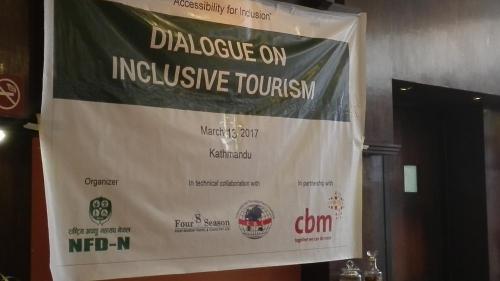
Following the last year historic “Heroes Trekking” expedition in which a dozen of American citizens living with disabilities travelled to Nepal to experience the Himalaya, the momentum is building on the concept of inclusive tourism that, simply put, means opening up the vast and diverse cultural and natural heritage of Nepal to tourists living with disabilities.
The potential, till vastly untapped, is huge for the country as creating a conducive environment for foreign tourists living with disabilities to visit Nepal can bring tremendous opportunities for the tourism industry in general but also, and this is very important, for nepali citizens living with disabilities.
Local youths living with disabilities could themselves become the “brand ambassador” of a new form of social business if provided with the opportunities of getting employed by the industry or if given the right support for them to become hospitality entrepreneurs.
As testimony of the opportunities that Nepal offers, John E. Heather, a faculty member of the Donald R. Tapia School of Business at Saint Leo University in Florida and expert on international tourism, recently visited Nepal to better understand the local context and support the process of mapping out a way forward to boost inclusive tourism locally.
On the 13th of March, a consultation was held in Kathmandu with Mr. Heather and key stakeholders from the disability community to hear their perspectives and understanding of inclusive tourism.
As for the Heroes Trekking expedition, only a strong collaboration between private sector and not for profit made this consultation possible.
Organized by the National Federation of the Disabled Nepal, with support of Four Season Travel & Tours, a leading operator breaking new ground and innovating in the sector of inclusive tourism, in partnership with the International Development Institute based, a not for profit in Washington DC and with the key support of CBM, a leading INGO working in the sector of disabilities, the consultation offered new insights on a possible pathway to promote inclusive tourism in Nepal.
The program also offered a learning platform to know the insights from a global expert of the sector like Mr. Heather that defined the development of inclusive tourism in Nepal as “a snowball that is getting bigger and bigger and moving faster but cannot lose momentum or otherwise it will falter and melt”.
Mr. Heather made it crystal clear that accessibility can be truly a good business for Nepal, a way to diversify and expand the segments of visitors coming to the country, especially if we take into account that the country is not starting from scratch and can be truly become a pioneer throughout the Asia Pacific region.
It is essential, according to Mr. Heather, to forge new collaborations and partnerships and this is one of the reasons why, during his stay in Nepal, he consulted and discussed with a great deal of stakeholders, including representatives of hospitality training centers, the Nepal Tourism Board and development agencies.
The consultation held last Monday was really important because local activists not only must be taken fully on board but also because they must be fully aware on what could be achieved if the tourism sector embraces diversity.
For example, as the Government is expanding with the support of the Embassy of Switzerland the vocational sector, the hospitality academies could design special apprenticeship schemes for youths living with disabilities where partial or full scholarships can be offered thanks to the involvement of the hotel industry.
The existing luxurious hotels in the countries could invest by training and hiring local youths with disabilities or otherwise if they miss out the opportunity ( yes it is an opportunity!), well there is no better way for the upcoming international hotels to boost an inclusive image founded on genuine inclusive practices.
There are three broadly stages to develop inclusive tourism as explained by Mr. Heather: the first is all about creating awareness. Tourists with disabilities have money to spend but are we ready to welcome them? Does industry grasp the added value of their presence? Second it is all about understanding the huge opportunities offered by inclusive tourism and third and final is about integration, getting persons with disabilities taking the lead and benefit the most out of it.
At the same time, we should not forget accessibility is a holistic concept. Making Nepal accessible for tourists with disabilities does not imply just building ramps.
As advocated during the consultation by Dr. Sunita Maleku, Chair of Autism Care Nepal Society, accessibility is also about taking into account, for example, in the airports or in the hotels, the special needs of persons with autism or other developmental disabilities too.
With Nepal currently between the first and second stage of development of the sector, we need vision, long term perspectives and commitment to invest to build bridges and make Nepal a truly best practice in the sector of inclusive tourism.










Add new comment